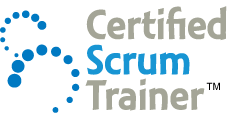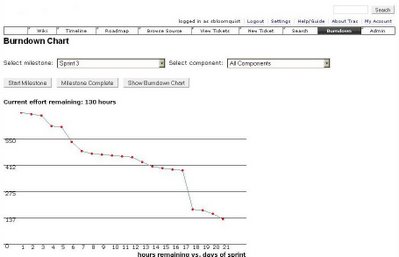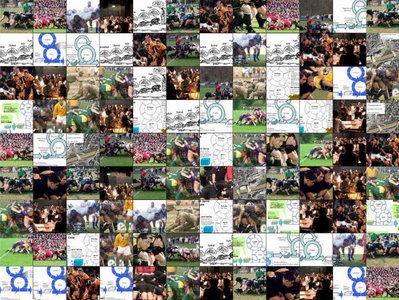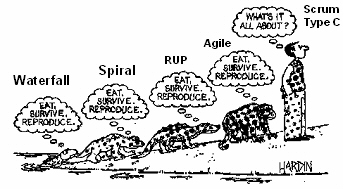ScrumMaster Certification Boston

18-19 April 2007 Boston
17-18 May 2007 Boston
8-9 Nov 2007 Boston
Get certified by Jeff Sutherland, Co-Creator of Scrum. Signup using Google or PayPal checkout buttons on left. Or email Purchase Orders or fax to 617-812-8527.
Jeff started the first Scrum at Easel Corporation in 1993 and worked with Ken Schwaber to emerge Scrum as a formal process at OOPSLA'95. Together, they extended and enhanced Scrum at many software companies and IT organizations and helped write the Agile Manifesto.
Springtime is a wonderful time of year in Boston and the course will be given at PatientKeeper, home of the first All-At-Once Scrum driving the whole company to market leadership in their product space. Jeff is the PatientKeeper CTO and Worldwide Scrum Consulting Practice Manager. He will be assisted in leading the course by the PatientKeeper Product Owner who will review Product Backlog management for the company's product portfolio. They will describe how to automate and manage Sprint Backlogs for multiple teams developing a wide variety of integrated and interoperable products.
The PatientKeeper Chief Product Owner leads the weekly MetaScrum which resources, starts, stops, and changes all Sprints to deliver dozens of production releases a year to large enterprise healthcare systems. Mary Poppendieck, in her latest book on Lean Software Development comments:
Five years ago a killer application emerged in the health care industry: Give doctors access to patient information on a PDA. Today there is no question which company won the race to dominate this exploding market; PatientKeeper has overwhelmed its competition with its capability to bring new products and features to market just about every week. The sixty or so technical people produce more software than many organizations several times larger, and they do not show any sign that the size of their code base is slowing them down.
A key strategy that has kept PatientKeeper at the front of the pack is an emphasis on unprecedented speed in delivering new features. It will not surprise anyone who understands Lean that PatientKeeper has to maintain superb quality in order to support its rapid delivery. CTO Jeff Sutherland explains it this way:
"Rapid cycle time: * Increases learning tremendously * Eliminates buggy software because you die if you don't fix this. * Fixes the install process because you die if you have to install 45 releases this year and install is not easy. * Improves the upgrade process because there is a constant flow of upgrades that are mandatory. Makes upgrades easy. * Forces quick standardization of software via new features rather than customization and one off. * Forces implementation of sustainable pace.. You die a death of attrition without it. * Allows waiting to build new functionality until there are 4-5 customers who pay for it. This is counterintuitive, and caused by the fact everything is ready within 90 days."
As part of the unique opportunity to work for two days within a Scrum company, there is a large open space Atrium which is ideal for group exercises. Participants will learn everything necessary for getting started with Scrum. There are very few rules to Scrum so it is important to learn its fundamental principles by experiencing them.
In this course, participants gain hands-on practice with the release backlog, sprint backlog, the daily Scrum meeting, tracking progress with a burndown chart, and more. Participants experience the Scrum process through a "59-minute Scrum" and the "XP Game" which simulate Scrum projects through a non-technical group exercises.
This course is equally suited for managers, programmers, testers, analysts, product managers, and others who are interested in working on or with a Scrum team. You will leave with solid knowledge of how and why Scrum works. Through practical, hands-on exercises and small-group discussion you will be prepared to plan your first sprint immediately after this class.
The course will run from 9am-5pm each day. A continental breakfast and lunch will be provided.
Following the course, each participant is enrolled as a Certified ScrumMaster, which includes a one-year membership in the Scrum Alliance, where additional ScrumMaster-only material and information are available.
Who Should Attend
Whether you're a manager, programmer, tester, analyst, product manager, or someone interested in working on or with a Scrum team, this course is suited for you. You will leave with solid knowledge of how and why Scrum works. Through practical, hands-on exercises and small-group discussion you will be prepared to plan your first sprint immediately after this class.
PMPs: You can receive 16 Professional Development Units (PDUs) for this course.
Course Material:
Click here for course syllabus.
Participants will receive course materials for review upon registration. The CSM course was formulated to train and certify ScrumMasters and is used worldwide for ScrumMaster training. The book, Agile Project Management with Scrum, by Ken Schwaber is required reading for the course and the course is based on the primary Scrum book, Agile Development with Scrum.
Logistics Information

http://maps.google.com/maps?q=275+Washington+St,+Newton,+MA&ie=UTF8&z=15&om=1&iwloc=addr
Boston CSM Trainings are held in the PatientKeeper Board Room on the second floor of 275 Washington Street in Newton, MA. This is directly off the Mass. Pike and across the street from the Sheraton Hotel, only about a 10-15 minute drive from Logan Airport or from Harvard Square.
PatientKeeper, Inc.
275 Washington Street - Second Floor
Newton, MA 02458
+1 617 987-0394
+1 617 812-8527 fax
PatientKeeper has a special rate of $179 at the Newton Marriott. Click on
http://cwp.marriott.com/bosnt/patientkeeper/ to get this rate which also includes "Wired for Business" (unlimited high speed, unlimited local telephone calls and unlimited domestic long distance).
The Newton Marriott is approximately 6 miles (and about 10-12 minutes) from the corporate office. http://marriott.com/hotels/travel/bosnt-boston-marriott-newton/
You can call the hotel directly at (617) 969-1000 or the Marriott Worldwide Reservations line at (800) 228-9290. Just be sure to mention the PatientKeeper "P1K" rate!
Airport Shuttle Reservations:
The Boston Marriott Newton Hotel has a contracted rate for airport transfers with Knights for $28.00 per way with direct service from Logan International to The Boston Marriott Newton Hotel. Advanced Reservations are required by booking online at http://www.knightslimo.com or calling Knights at (800) 822-5456.
Shuttle to PatientKeeper:
For service to and from the Boston Marriott Newton Hotel to PatientKeeper's Newton office, we have negotiated rates with US Limo and each traveler will pay own expenses with US Car Service with your own credit card. To make shuttle reservations, please contact US Limo at 508-494-1015. The rates are outlined as follows:
$18/way for a Sedan which accommodates up to 3 passengers
$35/way for an SUV which accommodates 4 – 6 passengers
$50/way for a Van which accommodates 7-14 passengers
Remember there are many other good hotels in the Harvard area near PatientKeeper. Check www.hotels.com or your favorite travel site for hotels in Cambridge, MA, and pick one that fits your price.
The fee for Certified ScrumMaster Training is $1200. You can register in three ways:
1. Fax a Purchase Order to PatientKeeper at 617-812-8527.
2. Send a check to Jeff Sutherland, PatientKeeper, Inc., 20 Guest Street, Suite 500, Brighton, MA 02135.
3. Use the Google Buy Now button on the upper left side of this page.
Refund policy: Rescheduling to another date for the same course is free at any time. 90% of the course fee will be refunded for cancellations more that 7 days in advance of the course. No refunds will be provided for cancellations within a week of the course.
 Scrum is an Agile development framework that Jeff Sutherland invented at Easel Corporation in 1993. Jeff worked with Ken Schwaber to formalize Scrum at
Scrum is an Agile development framework that Jeff Sutherland invented at Easel Corporation in 1993. Jeff worked with Ken Schwaber to formalize Scrum at 





